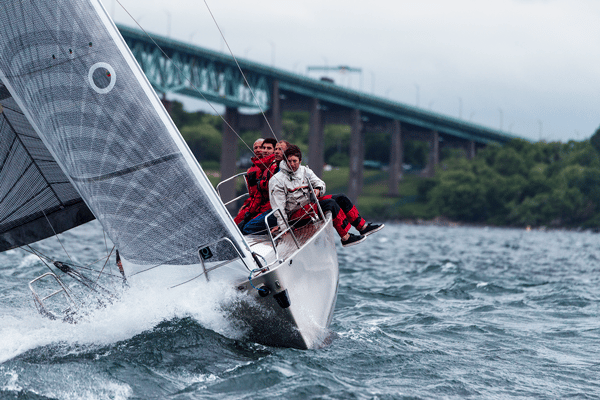
What we consider “speed” is actually our relative speed to the other boats around us. When trying to determine your speed, it helps to go through a short list of main factors to determine what’s slowing you down.
I like to divide the big “speed pie” into four main slices. I call them the Fantastic Four. Let’s take a look at them separately so you can ask the right questions.
1. Equipment
Equipment is a pretty straightforward part of our speed pie. You don’t only need the right equipment, but it also needs to be maintained and prepared properly. Your hull and foils need to be clean and in perfect shape, especially the foils. They need to be immaculate (just because you don’t see them while sailing, doesn’t make them any less important).
The choice of sails and rig combination needs to be optimized for the given sailing conditions as well. This is often a tough choice, as in most classes you can’t measure in different sets of sails and rigs. If you are just getting into a class, it’s worth doing your homework and getting your hands on the equipment that has been doing well.
Questions to ask about equipment include:
- Do we have the right sails for these conditions (no need to ask if you have Quantum sails)?
- Does our mast have the right stiffness?
- Is our hull in good shape and can it hold tension?
- Are our foils clean (seaweed or a plastic bag will slow you down quickly!)?
2. Settings
Anything that isn’t changed on a continuous basis while sailing is a setting. This includes your basic rig settings, such as mast rake, shroud tensions, and mast step position, as well as rudder angle, keel position, vang tension, Cunningham, traveler position, jib car position, jib Cunningham, and similar.
If you’re working with a sparring partner, it’s best to have the same person set up and measure the various settings in order to compare apples to apples. Different ways of measuring and different instruments will give you unreliable data, which will not allow for comparative purposes.
Questions to ask regarding settings include:
- How do our main traveler positions compare?
- Where are our jib cars?
- How much vang do we have?
- How much rake do we have?
3. Weight
Sometimes the only noticeable difference between two boats is the way the teams move their weight around. In lighter boats that react to weight shifting accordingly, this can be a crucial speed factor, especially downwind. Upwind, we are mainly looking at differences in weight position (fore/aft) and hiking form. It goes without saying that, in the breeze, it’s a must to be max weight and hiking hard.
Questions to ask regarding weight include:
- Is our weight in the right spot?
- Are we hiking adequately?
- Are we moving our weight fore/aft and in/out adequately?
- Are we max weight?
4. Technique
Technique includes everything dynamic, such as steering and trimming. For example, upwind for the helmsman in the Melges 24, the dilemma is often having to choose which primary control to work with. The traveller, mainsheet, and backstay all influence the amount of power in the boat, but they work in different ways.
Steering technique is a huge speed factor, especially if there is a difficult sea state. In simplified terms, steering can be broken down into amplitude (how far the tiller is moved) and frequency (how quickly the tiller is moved). The timing of the tiller movement in relation to the puff (or lull) and the arriving wave is key too. Having someone on your team calling the puffs (and lulls!) and waves will help you get it right more often and more quickly.
Downwind trimming is another key speed ingredient. Different conditions ask for different trimming techniques. Compare your trimming technique by watching the amount of curl on the luff of the other kites
Questions to ask regarding technique include:
- How much steering is needed?
- What should the primary upwind control be?
- To which extent are they playing the jib (or genoa)?
- How much curl are they carrying in their kite?
- Are we pumping efficiently?
These four factors are the main influence on our speed through the water, but sometimes we can do everything right and still seem slow. This happens occasionally when we’re on the wrong side of a shift, or we have a sub-par lane and can’t get the bow down in order to get up to speed.
As a helmsman, I am acutely aware of any kind of shift or change of pressure when we are tuning with another boat. After every run, I provide feedback to my tactician on what happened during those two minutes in order to put the performance in a better perspective.
So the next time you are not feeling up to speed, work through the Fantastic Four:
- Equipment
- Settings
- Weight
- Technique
And if that doesn’t help, just blame it on the shift!









